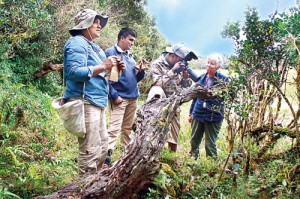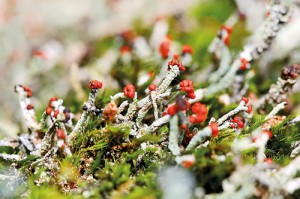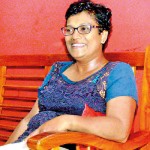Lichen hunter
Clambering up a tall tree in the dark and dank Sinharaja to get a closer look at some lichens on a branch, she was assailed by an uncanny feeling of being watched.
A sideways glance and Lichenologist Dr. Gothamie Weerakoon found herself mesmerised by an unblinking gaze. Watching her intently, as if questioning what she was doing in its territory, was a creature that sent a chill down her spine.

From left Dr. Gothamie Weerakoon, Field Assistant Omal Arachchige, Photographer Dushantha Wasala and Dr. Pat Wolseley of the Natural History Museum, UK at Horton Place February 24.
Forked tongue out, at very close, ‘striking’ quarters was a green-pit viper (pala polonga)!
“It was no laughing matter then,” says Dr. Weerakoon who throwing dignity to the winds, slithered and scrambled down the tree in a mighty hurry.
Armed with the prestigious ‘Annual Grantee Award’ of the National Geographic Society, given for the first time to a woman scientist in South Asia, Dr. Weerakoon has been trekking, toiling and camping in the wilds not only of Sinharaja, Wilpattu, Horton Plains, Ratnapura, Rakwana and Nivithigala but also Jaffna and some coastal areas, to study lichens.
The National Geographic Society headquartered in Washington DC, United Sates of America (USA) describes itself as “inspiring people to care about the planet since 1888”. It is one of the largest non-profit scientific and educational institutions in the world with interests in geography, archaeology and natural science and the promotion of environmental and historical conservation.
When we meet her in Colombo this week on a hurried trip away from her lichens, there is mirth in hindsight, about narrow shaves and startling encounters. For Dr. Weerakoon’s findings far outweigh what she calls the minor discomforts and dangers she has had to face.
Numerous new lichens not recorded before have been found by Dr. Weerakoon, a Scientific Affiliate at the Integrative Research Center of the Field Museum of Natural History, Chicago, USA, who is on this special mission to her home country.

(Red lichen) Cladonia coccifera Pix by Dushantha Wasala
“Many are the new findings on lichens,” she says, adding that in the last two years more than 60 new lichens have been discovered in Sri Lanka. “In connection with lichen diversity, Sri Lanka is a hotspot for the family of Graphidaceae.” [Lichens are symbiotic organisms, mainly composed of a fungal partner (mycobiont) and one or more photosynthetic partners (photobiont) most often either a green algae or cyanobacterium.]
When asked, Dr. Weerakoon who is one of just three Sri Lankan lichenologists says that the National Geographic Society’s award may be the first Asian award for lichenological research and she believes she has been honoured with it because she has made many lichen-related discoveries and also has many publications to her name.
This Lichenologist’s latest expeditions, both in the Dry and Wet Zones of Sri Lanka, have unearthed a huge 4,000 species of lichens, whereas earlier there were only 600 recorded.
Unfazed by blood-sucking leeches, reptiles such as green-pit vipers and Forsten’s cat snakes (le mapilas) and being charged by elephants, she has stuck to her work with lichens. “Some debaras were not very happy when I got too close to their nests,” she recalls.
The research grant which has brought her to Sri Lanka for three months and is keeping her away from her laboratory in the USA has been awarded for her to dig out the diversity of lichens in the Wet Zone as well as some other locations in the montane region.
Just last year, Dr. Weerakoon came up with research which clearly indicated that the botanical name of Sri Lanka’s ‘Old Man’s Beard’ which had been in use for more than 150 years was a misnomer. It should fall under the ‘Ramalina’ genus, she contended, even though it has been grouped under the genus of ‘Usnea’ which is found in Europe. (Genus is a group of plants that include several or many different species.)

Dr. Gothamie Weerakoon
She also delivered the ‘invitee address’ on ‘South Asian lichen diversity, new findings and how lichens can be used as bio-indicators to monitor forest status in this region’ at the annual conference of the British Lichen Society in January 2014 at the University of Nottingham.
Dr. Weerakoon is a consultant on two Asian lichen projects in Vietnam and Borneo being carried out by the Natural History Museum of London.
Three of her latest research papers, meanwhile, will be published in the scientific journal ‘Phytaxa’ this year and she is also working on a lichen ‘electronic online key’ for the world famous ‘Key to Nature’ which has no such entry so far for lichens.
When finally Dr. Weerakoon’s current assignment ends, Sri Lanka which did not possess a ‘national collection of lichens’ will be the proud owner of one safely deposited at the National Herbarium at the Peradeniya Botanical Gardens.
Sri Lanka has so much to offer the world on lichens, she says, adding that there still remains so much unexplored. Dr. Weerakoon sees it as her quest to put Sri Lanka on the map with regard to its humble lichens.
Much more than just research
Dr. Gothamie Weerakoon’s work is not limited to her laboratory, research papers and arduous field assignments.
While on March 12 she will release a book on ‘Fascinating Lichens of Sri Lanka’, she has also organised three International Lichenological Workshops with three eminent international lichenologists right here in this country.
The book supported by Dilmah Conservation is believed to be the first-ever lichen guide in Sri Lanka and will feature 150 common species.
The workshops, meanwhile, will be held in Kandy from March 5 to 7 at the Peradeniya Botanic Gardens; in Colombo on March 11 at the Sri Lanka Foundation Institute; and in Jaffna on March 21 & 22 at the Jaffna University.
The three international resource persons for the workshops are the Scientific Associate, Natural History Museum, United Kingdom, Dr. Pat Wolseley, Dr. Andre Aptroot of the ABL Herbarium in the Netherlands and Dr. Marcela E. S. Cáceres of the Federal University of Sergipe, Brazil.
The local collaborators for the workshops are the Director-General of the Department of National Botanic Gardens, Dr. Siril Wijesundera, Prof. Veranja Karunaratne of the Peradeniya University’s Chemistry Department and Dr. Udeni Jayalal, Senior Lecturer at the Sabaragamuwa University.
The workshops will be telecast across the country as a special programme on the National Geographic Channel.


